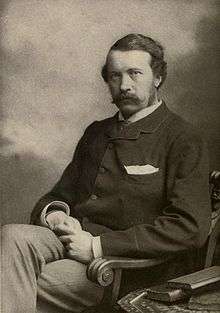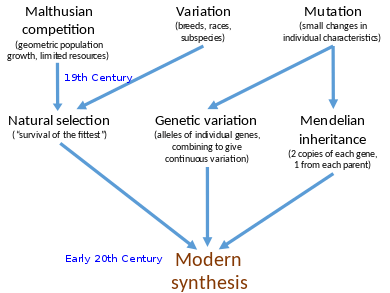Neo-Darwinism

Neo-Darwinism is the interpretation of Darwinian evolution through natural selection as it has variously been modified since it was first proposed. It was early on used to name Charles Darwin's ideas of natural selection separated from his hypothesis of pangenesis as a Lamarckian source of variation involving blending inheritance.[1]
In the early 20th century, the concept became associated with the modern synthesis of natural selection and Mendelian genetics that took place at that time.
In the late 20th century and into the 21st century, neo-Darwinism denoted any strong advocacy of Darwin's thinking, such as the gene-centered view of evolution.
Early usage
As part of the disagreement about whether natural selection alone was sufficient to explain speciation, in 1880, Samuel Butler called Alfred Russel Wallace's view neo-Darwinism.[2][3]
The term was again used by George Romanes in 1895 to refer to the version of evolution advocated by Wallace and August Weismann with its heavy dependence on natural selection.[4]
Weismann and Wallace rejected the Lamarckian idea of inheritance of acquired characteristics that even Darwin took for granted.[5][6] The term was first used to explain that evolution occurs solely through natural selection, and not by the inheritance of acquired characteristics resulting from use or disuse.[7] The basis for the complete rejection of Lamarckism was Weismann's germ plasm theory. Weismann realised that the cells that produce the germ plasm, or gametes (such as sperm and egg in animals), separate from the somatic cells that go on to make other body tissues at an early stage in development. Since he could see no obvious means of communication between the two, he asserted that the inheritance of acquired characteristics was therefore impossible; a conclusion now known as the Weismann barrier.[8]
From the 1880s to the 1930s, the term continued to be applied to the panselectionist school of thought, which argued that natural selection was the main and perhaps sole cause of all evolution.[9] From then until around 1947, the term was used for the panselectionist followers of Ronald Fisher.

Modern synthesis of the early 20th century
Following the development, from about 1918 to 1947, of the modern synthesis of evolutionary biology, the term neo-Darwinian was often used to refer to that contemporary evolutionary theory.[10][11]
Any current version of evolutionary thinking
Biologists however have not limited their application of the term neo-Darwinism to the historical modern synthesis. For example, Ernst Mayr wrote in 1984 that "the term neo-Darwinism for the synthetic theory [the modern synthesis of the early 20th century] is wrong, because the term neo-Darwinism was coined by Romanes in 1895 as a designation of Weismann's theory."[12][1][7][13] Publications such as Encyclopædia Britannica similarly use neo-Darwinism to refer to current evolutionary theory, not the version current during the early 20th century synthesis.[14] Richard Dawkins and Stephen Jay Gould have used the term in their writings and lectures to denote the forms of evolutionary biology that were contemporary when they were writing.[15][16]
See also
References
- 1 2 Kutschera, Ulrich; Niklas, Karl J. (June 2004). "The modern theory of biological evolution: an expanded synthesis". Naturwissenschaften. Heidelberg: Springer-Verlag Heidelberg. 91 (6): 255–276. Bibcode:2004NW.....91..255K. doi:10.1007/s00114-004-0515-y. PMID 15241603.
- ↑ Butler, Samuel (1880). Unconscious Memory. David Bogue. p. 280.
I may predict with some certainty that before long we shall find the original Darwinism of Dr. Erasmus Darwin … generally accepted instead of the neo-Darwinism of to-day, and that the variations whose accumulation results in species will be recognised as due to the wants and endeavours of the living forms in which they appear, instead of being ascribed to chance, or, in other words, to unknown causes, as by Mr. Charles Darwin's system
- ↑ Beccaloni, George (2013). "On the Terms "Darwinism" and "Neo-Darwinism"". A. R. Wallace Website.
- ↑ Gould 2002, p. 216
- ↑ Darwin 1872, p. 108
- ↑ Kutschera, Ulrich (December 2003). "A comparative analysis of the Darwin-Wallace papers and the development of the concept of natural selection". Theory in Biosciences. Jena; Berlin & Heidelberg: Urban & Fischer; Springer-Verlag. 122 (4): 343–359. doi:10.1007/s12064-003-0063-6. ISSN 1431-7613.
- 1 2 Reif, Wolf-Ernst; Junker, Thomas; Hoßfeld, Uwe (March 2000). "The synthetic theory of evolution: general problems and the German contribution to the synthesis" (PDF). Theory in Biosciences. Jena; Berlin & Heidelberg: Urban & Fischer; Springer-Verlag. 119 (1): 41–91. doi:10.1007/s12064-000-0004-6. ISSN 1431-7613.
- ↑ Barbieri, Francisco D. (1989). "The origin of Metazoa and Weismann's germ line theory". Rivista di Biologia. Pisa; Rome: Perugia Anicia Srl. 82 (1): 61–74. ISSN 0035-6050. PMID 2665023.
- ↑ Wilkins, John (December 21, 1998). "So You Want to be an Anti-Darwinian: Varieties of Opposition to Darwinism". TalkOrigins Archive. Houston, TX: The TalkOrigins Foundation, Inc. Retrieved 2015-11-19.
- ↑ Moran, Laurance (January 22, 1993). "The Modern Synthesis of Genetics and Evolution". TalkOrigins Archive. Houston, TX: The TalkOrigins Foundation, Inc. Retrieved 2007-09-19.
- ↑ Bock, Walter J. (July 1981). "Reviewed Work: The Evolutionary Synthesis. Perspectives on the Unification of Biology". The Auk. American Ornithologists' Union. 98 (3): 644–646. ISSN 0004-8038. JSTOR 4086148.
- ↑ Mayr, Ernst (1984). "What is Darwinism Today?". PSA: Proceedings of the Biennial Meeting of the Philosophy of Science Association. Chicago, IL: University of Chicago Press on behalf of the Philosophy of Science Association. 2: 145–156. ISSN 0270-8647. JSTOR 192502. Volume Two: Symposia and Invited Papers (1984).
- ↑ Pigliucci, Massimo (December 2007). "Do We Need An Extended Evolutionary Synthesis?" (PDF). Evolution. Hoboken, NJ: John Wiley & Sons for the Society for the Study of Evolution. 61 (12): 2743–2749. doi:10.1111/j.1558-5646.2007.00246.x. PMID 17924956.
- ↑ "neo-Darwinism". Encyclopædia Britannica. Chicago, IL: Encyclopædia Britannica, Inc. 2015. Retrieved 2015-11-19.
- ↑ "Neo-Darwinism Lecture by Richard Dawkins" on YouTube. The video of the lecture was originally posted on May 5, 2010, at old.richarddawkins.net: ""Lecture on Neo-Darwinism"". Archived from the original on December 1, 2014. Retrieved 2013-07-07. .
- ↑ Gould 2011, pp. 53–73
Bibliography
- Darwin, Charles (1872). The Origin of Species by Means of Natural Selection, or the Preservation of Favoured Races in the Struggle for Life (6th ed.). London: John Murray. OCLC 1185571.
- Gould, Stephen Jay (2002). The Structure of Evolutionary Theory. Cambridge, Massachusetts: Belknap Press of Harvard University Press. ISBN 0-674-00613-5. LCCN 2001043556. OCLC 47869352.
- Gould, Stephen Jay (2011). "Challenges to Neo-Darwinism and Their Meaning for a Revised View of Human Consciousness". In McMurrin, Sterling M. The Tanner Lectures on Human Values. 6. Salt Lake City, UT; Cambridge, UK: University of Utah Press; Cambridge University Press. ISBN 978-0-521-17647-7. OCLC 846869183. "Lecture delivered at Clare Hall, Cambridge University April 30 and May 1, 1984"